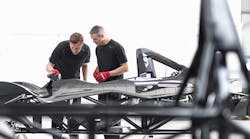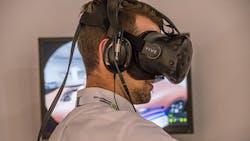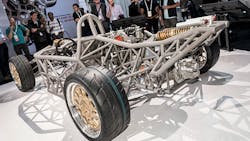One only has to see the latest news from automotive upstarts like Tesla, Uber and Alphabet’s Waymo — or even from evolving industry stalwarts like GM — to know that the very concept of automobiles is undergoing rapid change. While developments around self-driving autonomous vehicles might garner the most attention, there are a number of other shifts occurring that are fundamentally altering how cars are designed, made, and used — helping to shape the future of cars themselves.
Design Gets an Assist
The idea of a car’s final shape and form being guided solely by the vision in a designer’s head is being tweaked by the advent of generative design. Using generative design software allows designers and engineers to input design goals along with parameters such as materials, manufacturing methods, and cost constraints; the software then comes up with thousands of potential solutions that meet those goals.
This design approach can greatly assist with lightweighting, reducing the overall weight of components to improve fuel efficiency and handling. (Briggs Automotive Company has had particular success using Autodesk software to make the suspension of its customized, single-seater BAC Mono as lightweight as possible while providing uncompromising performance.)
Generative design can further evolve to encompass larger elements of the car. For example, manufacturing company Hack Rod used Autodesk’s generative design software, Project Dreamcatcher, to produce an optimally performing chassis for its La Bandita Speedster, after feeding the system massive amounts of performance data collected during previous road tests.
Because generative design is capable of producing shapes and forms the human mind might not even imagine, it also has huge potential to evolve cars from an aesthetic perspective. Grills, vents, and other adornments might take the shape of unfamiliar, flowing, organic patterns — while car bodies themselves could assume “outside the box” appearances.
All this attention to the exteriors of cars shouldn’t obscure the fact that designers will also need to pay particular attention to the interior of cars in the coming decades. As autonomous vehicles move into the mainstream, we will shift to riding as passengers rather than drivers — which changes the experience inside the car.
Maybe business travelers will want to have vehicles function as full-fledged mobile offices, with high-speed internet, video conferencing systems, and gesture-controlled screens that allow them to flip through their documents and files like Tom Cruise in “Minority Report”. Families might want to turn the car into a traveling movie theater with surround sound and full-height screens to keep young children entertained on long road trips. Location-based services could add an educational aspect to these family car rides by sensing the car’s location and beaming interesting factoids or historical information about the surrounding area onto the car’s screens.
In either case, there’s lots of room for innovation in the human-machine interface and the ways that humans interact with their cars as vehicles become massively more digital. Virtual reality will play a big role here by providing an immersive environment for automakers that helps them simulate and experience a passenger’s journey firsthand and allows them to effectively design for this new consumer experience.
Fabrication Gets Futuristic
Coming up with innovative designs is one thing — making them a physical reality is another matter. Fortunately, innovative materials and manufacturing methods are providing the industry with new ways to fabricate.
In 1980, designers could choose from about 60,000 different materials to work with. Today, the number is well over 300,000 — and it will likely double within a decade. For example, carbon composite materials are showing strong potential in the automotive space for their lightweighting capabilities. Even more intriguing, there is research being done around smart composites that are able to sense and communicate the stress that they’re under — information that can be extremely useful in understanding and improving vehicle performance.
Thanks to new forms of additive manufacturing, automotive manufacturers can quickly and easily generate components for their vehicles without a large upfront investment in tooling. In cases where generative design has been used for these components, additive is often a matter of necessity: many of the complex forms and shapes that generative design produces are simply impossible to make with traditional manufacturing methods.
Beyond materials and manufacturing methods, it’s likely that robots will increasingly be a part of how cars get made. In 2015, roughly 2 million multipurpose industrial robots were in use; by 2020, another half-million will be in service. Their sophistication and ubiquity has changed how we make things at an industrial scale.
Machine learning gives robots the ability to “see” and “think” for themselves, so that they’re not constrained by their original programming. In an automotive setting, a multi-functional robot can instantly switch from adding material to machining and polishing that material as needed. Taking this machine learning approach even further up the production chain, automotive manufacturers are now able to provide intelligent, self-monitoring production lines and connected smart factories.
Uses Emerge and Evolve
As surely as the way cars are designed and made is evolving, so too are the ways they are used. This change goes beyond the rise of autonomous vehicles — and our shift from drivers to passengers — to incorporate entire changes in usage patterns around automobiles.
In the 20th century, people purchased cars, dutifully filled them up at gas stations, and happily purchased whatever products the major automotive companies were offering, without regard for individualization or customization. All of that is changing.
For starters, the world is rapidly moving away from “car ownership.” Young adults and urban dwellers prefer paying for rides on an as-needed basis — via ride services like Uber and Lyft, or car share services like Zipcar — rather than paying a large, upfront amount to own a vehicle. There is an opportunity here for carmakers to use design to create products that appeal to multiple distinct audiences and use cases, including the conventional car buyer who is keen on the ownership experience, the ride-sharing user who wants a quick and affordable ride, and everyone in between.
Meanwhile, new electric drivetrains, combined with new types of batteries, will make electric vehicles an increasingly common presence on the roads — to the point where the next generation might have to explain to their children what “filling up at the pump” means. Design and engineering software will be important here in designing batteries with superior storage capacity and performance — helping extend the range that electric vehicles can travel, increasing their viability as a mobility solution.
Last, it’s easy to see how different regions might have different automotive needs, leading to regional variations on car production rather than a “one size fits all” approach. A country like Namibia, for example, might locally design automobiles that are specifically designed for desert conditions. Across the globe, a hilly urban environment like San Francisco might locally design vehicles that will suit their unique needs — allowing cars and the ways they are used to evolve in surprising and inventive ways.
This trend toward customization could eventually mean total personalization of vehicles based on a driver’s unique needs. Think of cars that are specifically optimized based on a driver’s height and weight, or age, or even whether they’re left-handed instead of right-handed. Every aspect of the car could be customized based on user preferences and requirements, and then manufactured on demand. It’s a heady possibility.
The Road Ahead
A lot has happened since Henry Ford set up an automated production line and turned out a Model T for public consumption. Today, automakers are facing changes that their predecessors never could have anticipated around how cars are designed, made, and used. These trends are part of a wider future of making things that will impact auto making in huge ways in the decade ahead. But with innovative thinking and the right technology, car manufacturers will be able to seize the opportunities created by this seismic shift and continue to drive the industry forward.






